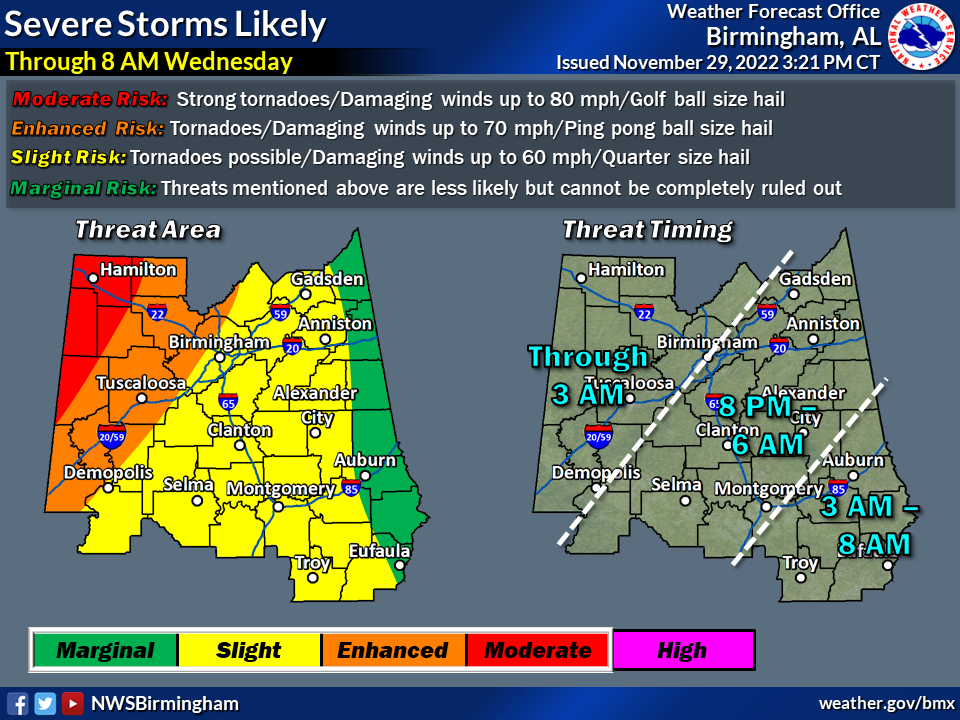Story updated at 4:21 p.m. on Nov. 29.
The National Weather Service is predicting an enhanced risk (3 out of 5) for severe weather including tornadoes, damaging winds up to 70 mph, and ping pong ball size hail for Tuscaloosa through 3 a.m., Wednesday, Nov. 30, as depicted in the graphic below. In addition, heavy rainfall may result in localized flooding.
Prepare for severe weather
Know the difference between a tornado watch and a warning. A tornado watch means conditions are favorable for tornadoes to form. When a watch is issued, pay attention to the weather and be ready to move to a safe place if a tornado warning is issued.
Tornado warnings are issued when a tornado has been sighted or is indicated on weather radar. When a warning is issued there is imminent danger to life and property, and you should immediately seek shelter.
All classes and campus events are immediately suspended when a tornado warning is issued.
Before storms arrive, familiarize yourself with UA’s severe weather guidelines.
The UA Safety app, which is available for iOS and Android devices, will notify you of weather watches and warnings for Tuscaloosa County.
UA will issue UA Alerts for all tornado watches and warnings that include the campus. Information about severe weather affecting Tuscaloosa can be found in the UA Safety app, on Twitter by following @UA_Safety and by listening to 92.5 FM UA Info Radio.
Know where to shelter
Sheltering on campus
Should a tornado watch be issued, UA’s sheltering locations will be available for students, faculty and staff until the watch expires.
The Magnolia Parking Deck Best Available Refuge Area can accept pets with their owners. Dogs should be in a crate or leashed and muzzled. All other animals must be in a crate. Pet owners are responsible for cleaning up after their pets. Learn more about sheltering with pets on campus.
If you are not able to make it to a storm shelter, seek shelter in the closest Best Available Refuge Area location. BARA locations for each building can also be found on the building emergency plan posted near entry/exit locations of each building and within the UA Safety app.
The explore feature in the UA Safety App can help you locate the nearest storm shelter or BARA.
Parking
During a tornado watch or warning, students can use any legal parking in proximity to a shelter or refuge area. When parking decks are filled to capacity, students should park in a surface lot near a shelter or refuge area. View the parking map on the shelters page to see available surface lot parking near shelters and refuge areas.
Do not create a hazard by illegally parking; that will impede others from getting access to parking.
During a severe weather event, parking enforcement staff monitor only for safety violations like blocking a roadway, fire hydrant, access lane or fire lane; as well as parking on the grass, double parking or disability parking. Once the watch has ended, ample time is allowed to return to correct parking zones, if applicable.
Sheltering off campus
Never seek shelter in a vehicle or a mobile home. If you live in an apartment building, seek shelter on the lowest level. Do not remain in apartments on upper floors. Tuscaloosa County has public storm shelters in Tuscaloosa and the surrounding areas.
If you are not on campus when a warning is issued, seek shelter on the lowest floor in the center of a sturdy building and stay away from windows.
For more information on what to do during a severe weather event, visit the Office of Emergency Management’s website and listen to 92.5 FM UA Info Radio.
After a storm
University police and staff will quickly respond to any storm damage that may occur on campus. Report any damage that you find to UAPD at 205-348-5454 or by sending a tweet to @UA_Safety.
If you live off campus and experience damage, stay clear of fallen power lines. Do not enter damaged buildings until you are told they are safe by emergency officials. Call 911 if you have an emergency.
Reach out to family members or friends either by text, call or through social media to let them know you are safe.
